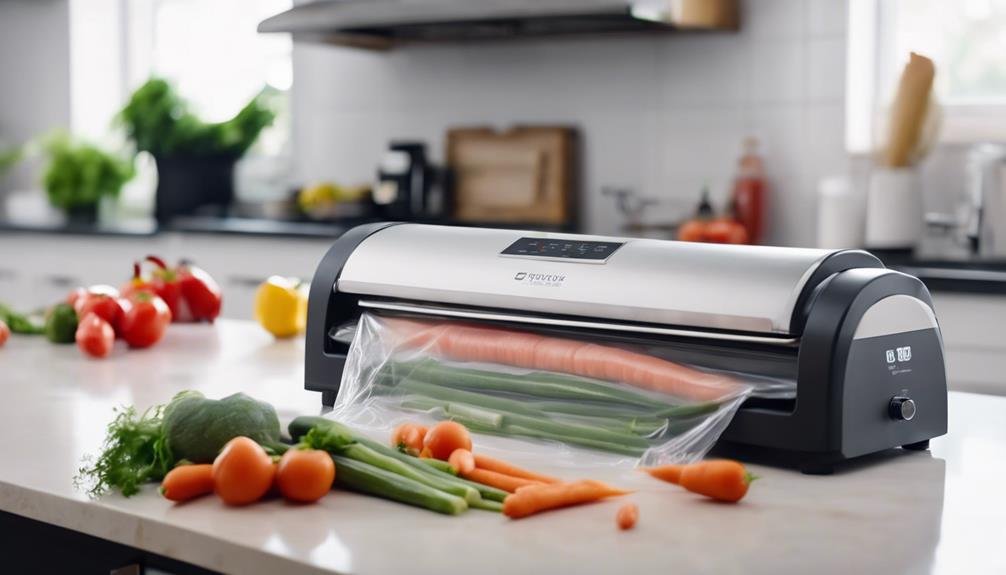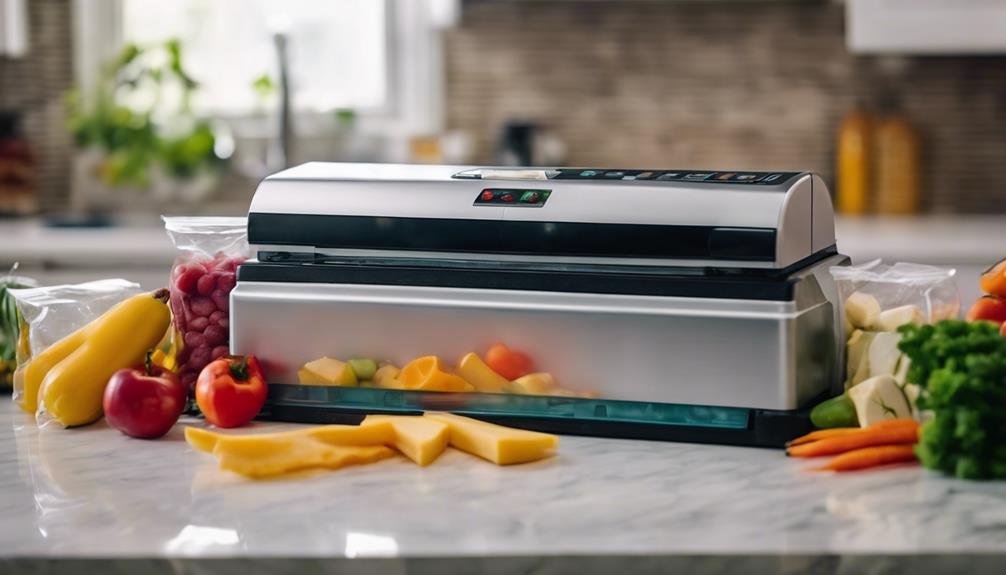Vacuum sealing keeps your food fresh by removing air from storage containers, creating an environment that inhibits bacterial growth and slows oxidation. By eliminating oxygen, you deprive bacteria and mold of a vital element they need to thrive. This process extends the shelf life of groceries up to five times longer, preventing freezer burn and maintaining flavor and texture. You'll preserve vibrant colors in fruits and vegetables while reducing food waste. Vacuum sealing allows you to buy in bulk and save money by preserving food for longer periods. With the right techniques and equipment, you can maximize the benefits of this food preservation method. Discover how to choose the best vacuum sealer and which foods are ideal for this process.
The Science Behind Vacuum Sealing
Vacuum sealing consistently relies on a simple yet effective scientific principle: removing air to inhibit bacterial growth and oxidation. This food preservation technique works by creating an airtight environment around your food, effectively extending its shelf life.
When you remove oxygen from the packaging, you're depriving bacteria and mold of the essential element they need to thrive and multiply.
But that's not all – vacuum sealing also slows down the oxidation process. You've probably noticed how some foods, like apples or avocados, turn brown when exposed to air. By removing oxygen, you're preventing this natural reaction, keeping your food looking fresher for longer.
This lack of air exposure also helps preserve the vibrant colors of fruits and vegetables, making them more appealing when you're ready to use them.
The science behind vacuum sealing is all about creating an environment that's inhospitable to the factors that lead to food spoilage. By removing air and sealing in freshness, you're not just preserving food – you're maintaining its flavor, texture, and nutritional value. It's a simple yet powerful way to extend the shelf life of your favorite foods.
Benefits of Vacuum Sealing Food
Having gained insight into how vacuum sealing works, let's explore its numerous benefits for food preservation. Vacuum sealing machines offer a remarkable way to keep your food fresh for longer periods. You'll be amazed at how this method can extend the shelf life of your groceries up to five times longer than ordinary storage techniques.
When you vacuum seal your food, you're not just preserving its freshness; you're also protecting its taste and quality. Here are some key benefits you'll experience:
- Prevent freezer burn on meats and vegetables
- Maintain the flavor and texture of cheese for months
- Keep baking essentials fresh for years
- Reduce food waste by extending storage times
- Save money by buying in bulk and preserving longer
Imagine being able to keep beef and poultry in your freezer for up to three years without compromising quality. Or having hard cheese stay fresh in your fridge for eight months. Even pantry staples like flour and sugar can last up to two years when sealed properly.
Choosing the Right Vacuum Sealer

When you're prepared to invest in a vacuum sealer, there are five key factors you'll need to take into account in order to find the perfect match for your needs.
First, consider the type of vacuum sealer that best suits your kitchen space and sealing requirements. Countertop models offer more features, while handheld versions are compact and portable.
Next, look for convenient features like roll storage and cutter bars, which allow you to customize bag sizes easily. These additions can save you time and reduce waste.
Third, choose durable, freezable, and microwave-safe bags or rolls to make certain your food stays fresh and can be reheated safely.
Don't forget to explore accessories like jar sealers and bottle stoppers, which expand your sealing options to various containers.
Proper Vacuum Sealing Techniques
To maximize the benefits of your vacuum sealer, you'll need to master proper sealing techniques. Vacuum sealing food is an excellent way to extend shelf life and preserve food by creating an airtight environment.
When using your vacuum sealer, make sure you're following these key steps:
- Remove excess air from the bag before sealing
- Place food items in a single layer for even sealing
- Leave enough space at the top of the bag for a secure seal
- Smooth out any wrinkles in the bag to prevent air pockets
- Clean the sealing area of the bag to guarantee a proper seal
Proper sealing techniques are essential for maintaining food freshness. You'll want to seal both moist and dry food items, as vacuum sealing can greatly extend their shelf life.
After sealing, don't forget to label and date your bags. This practice helps you track freshness and usage timelines easily.
For ideal food preservation, store your vacuum-sealed items in the refrigerator or freezer. Remember to clean and maintain your vacuum sealer regularly to ensure it continues to perform at its best, keeping your food fresh and safe for longer periods.
Best Foods for Vacuum Sealing

Certain foods are ideal candidates for vacuum sealing, while others don't fare as well in an airless environment. You'll find that vacuum sealed food can last up to five times longer than food stored using traditional methods. This technique protects food from freezer burn and keeps it fresh for extended periods.
The benefits of vacuum sealing are particularly noticeable with some foods:
| Food Type | Vacuum Sealed Shelf Life |
|---|---|
| Beef/Poultry | Up to 3 years (frozen) |
| Bread | 1-3 weeks |
| Flour/Sugar | Up to 2 years |
| Wine | Several weeks |
However, not all foods are suitable for vacuum sealing. Soft cheeses, bananas, and mushrooms don't respond well to this preservation method. When it comes to vegetables, you'll need to be selective. Cucumbers and potatoes don't freeze well when vacuum sealed, but you can successfully seal and freeze broccoli and peas after blanching.
Storage and Safety Considerations
While vacuum sealing offers numerous benefits, it's important to understand proper storage and safety practices to maximize food preservation and prevent potential health risks.
When you vacuum seal food, you're creating an airtight seal that inhibits bacterial growth and oxidation, leading to extended shelf life. However, it's vital to remember that vacuum sealing isn't a substitute for proper food storage techniques.
To guarantee food safety and maintain quality, consider these key points:
- Store vacuum-sealed perishables in the refrigerator or freezer
- Label packages with contents and date of sealing
- Use appropriate vacuum sealing bags for different food types
- Monitor for any signs of spoilage before consuming
- Follow recommended storage times for various foods
Conclusion
You've now got the tools to keep your food fresher for longer. Why settle for stale snacks or freezer-burned meats? With vacuum sealing, you'll reduce waste, save money, and enjoy better-tasting food.
Remember to choose the right sealer, master proper techniques, and store your sealed items correctly. By embracing this preservation method, you're not just extending shelf life – you're elevating your entire culinary experience.
Start sealing and savor the difference!
